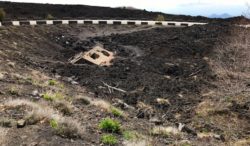Read Time: 6 Minutes Subscribe & Share
On The Road Again
 No matter where you station yourself on the Eastern side of Sicily, make sure you include on your route the Roman Villa of Casale in Piazza Amerina. Built in the 4th century AD, this wealthy estate survived earthquakes, floods, fires, and the fall of the Roman empire with its impressive collection of artwork remarkably intact. Pictures and videos give some beautiful hints, but nothing is as breathtaking as walking the recently redesigned platforms to visit the mosaics and remains of this archeological treasure. Plenty of parking, snack kiosks, and informative books in several languages make this a very easy place to visit. The mosaics were created by NorthAfrican slave craftsmen (remember Carthage, the long-standing enemy state of Rome, was in Tunisia and was bloodily defeated). It is interesting to note that marble floors in Roman homes indicated superior wealth and status, whereas mosaics were a second tier interior display of financial prestige. So marble floors are only featured in the great hall or basilica. In the case of this villa, the owner is thought to have supplied Rome with grain (Sicily was known as Rome’s granary) in addition to wild game from Africa and even India for the infamous Roman arenas. The Great Hunt scene has many intriguing insights, such as Roman huntsmen diverting a tigress by using a glass sphere so that the animal pounces on her own reflection and either she or her cubs are captured. Mosaic floor designs of slave quarters had a heirarchical order. Slave supervisors had slightly more ornate floors than worker slaves, while the mosaic patterns in the family’s quarters are stunning in their diversity. The most famous are the female athletes attired in gear that puts Lululemon to shame.
No matter where you station yourself on the Eastern side of Sicily, make sure you include on your route the Roman Villa of Casale in Piazza Amerina. Built in the 4th century AD, this wealthy estate survived earthquakes, floods, fires, and the fall of the Roman empire with its impressive collection of artwork remarkably intact. Pictures and videos give some beautiful hints, but nothing is as breathtaking as walking the recently redesigned platforms to visit the mosaics and remains of this archeological treasure. Plenty of parking, snack kiosks, and informative books in several languages make this a very easy place to visit. The mosaics were created by NorthAfrican slave craftsmen (remember Carthage, the long-standing enemy state of Rome, was in Tunisia and was bloodily defeated). It is interesting to note that marble floors in Roman homes indicated superior wealth and status, whereas mosaics were a second tier interior display of financial prestige. So marble floors are only featured in the great hall or basilica. In the case of this villa, the owner is thought to have supplied Rome with grain (Sicily was known as Rome’s granary) in addition to wild game from Africa and even India for the infamous Roman arenas. The Great Hunt scene has many intriguing insights, such as Roman huntsmen diverting a tigress by using a glass sphere so that the animal pounces on her own reflection and either she or her cubs are captured. Mosaic floor designs of slave quarters had a heirarchical order. Slave supervisors had slightly more ornate floors than worker slaves, while the mosaic patterns in the family’s quarters are stunning in their diversity. The most famous are the female athletes attired in gear that puts Lululemon to shame.
Stay In Giardini Naxos – Visit Taormina
The vacation real estate team for the Italy Insider chose Giardini Naxos as our next home base. Although more commercial than the dream spot in  Scopello, this beach resort was the first Greek colony in Sicily and we viewed it as a much more pleasant place to stay than Taormina. Hotels and apartments abound along the sandy beaches, punctuated by wildly configured solidified black lava floes. We chose an apartment that had its own little beach and miniature cove of lava rocks, which the boys loved to play in. Several beach clubs are open with covered terraces to have breakfast, lunch, or even a casual dinner. The one we frequented also had a lovely beach playground. Do eat at Ristorante Cambusa and also try the wine tastings with lovely snacks at Il Calice dei Nobili . But wherever you stay, whatever touring activities you take up, do not pass up the opportunity to use www.taxitaormina.it. run by Romano and Stephanie, a local couple with a team of drivers who can whisk you up Mount Etna or to a butcher for Suino Nero that is so succulent, you’ll have a hard time going back to “the other white meat” in the US.
Scopello, this beach resort was the first Greek colony in Sicily and we viewed it as a much more pleasant place to stay than Taormina. Hotels and apartments abound along the sandy beaches, punctuated by wildly configured solidified black lava floes. We chose an apartment that had its own little beach and miniature cove of lava rocks, which the boys loved to play in. Several beach clubs are open with covered terraces to have breakfast, lunch, or even a casual dinner. The one we frequented also had a lovely beach playground. Do eat at Ristorante Cambusa and also try the wine tastings with lovely snacks at Il Calice dei Nobili . But wherever you stay, whatever touring activities you take up, do not pass up the opportunity to use www.taxitaormina.it. run by Romano and Stephanie, a local couple with a team of drivers who can whisk you up Mount Etna or to a butcher for Suino Nero that is so succulent, you’ll have a hard time going back to “the other white meat” in the US.
 Romano is one of those larger-than-life figures you assume are part of Hollywood fiction. He took us on a marvelous family oriented tour of Taormina, gave us excellent advice, and dropped us at Castillo de Castelmola (which we would never found on our own). He advised us to lunch there and try the vino de mandorle (not a liqueur but an actual wine made from white almonds) which I brought home and used for zabaglione. The views are spectacular, as anywhere you sit in this village is precariously perched on a peak. Look at this post from Julia’s Album to get a hint of why you should spend a few spectacular hours at Castelmola.
Romano is one of those larger-than-life figures you assume are part of Hollywood fiction. He took us on a marvelous family oriented tour of Taormina, gave us excellent advice, and dropped us at Castillo de Castelmola (which we would never found on our own). He advised us to lunch there and try the vino de mandorle (not a liqueur but an actual wine made from white almonds) which I brought home and used for zabaglione. The views are spectacular, as anywhere you sit in this village is precariously perched on a peak. Look at this post from Julia’s Album to get a hint of why you should spend a few spectacular hours at Castelmola.
Taormina, below Castelmola, has one of the easiest Amphitheaters to explore, due to its intimate size. It is still used for  performances. The video below amplifies what it was like centuries ago. Although the original layout was most likely Greek, the extensive use of brick makes this theater distinctly Roman. A dining note: Unless you have researched restaurants and reserved tables ahead of your Taormina visit, casual dining is expensive, and not particularly wonderful.
performances. The video below amplifies what it was like centuries ago. Although the original layout was most likely Greek, the extensive use of brick makes this theater distinctly Roman. A dining note: Unless you have researched restaurants and reserved tables ahead of your Taormina visit, casual dining is expensive, and not particularly wonderful.
You should absolutely visit the Mars-like landscape of Mount Etna – a trip made more memorable with Romano. He provided a narrative, along with views of real estate casualties on a series of moribund and not-so-moribund volcanic mountains that cover over 400 miles. Mount Etna is moving towards the Mediterranean Sea at an average rate of a bit over one-half inch per year. And naturally Romano knew the best places on Mt. Etna to eat arancini and cannoli.
https://www.youtube.com/watch?v=oTVUgf3YWp0
Following The Footsteps of Polyphemus
Since we were so close to the most southern point of Sicily, it was neat to take time to view the spot where the Mediterranean and Ionian Seas meet in Portopalo di Capo Passero. To fortify yourself as you walk on this beach observing the mingling currents of two history- and mythology-laden seas, make a reservation at Ristorante Scala in Portopalo. You will not be disappointed.
 We learned a couple of other pointers to pass onto KD readers. In Noto, you can easily park and walk through the main streets and visit the almost paper cut-out architecture, but grab a parking place wherever you can in Ragusa and use the mini-train, which you can hop on and off following your own itinerary. In the older part of Ragusa, we found a lovely centrally located restaurant, Trattoria Agli Archi , which has now become famous on our Instagram feed for its blood orange tiramisu and our grandson eating pasta English style.
We learned a couple of other pointers to pass onto KD readers. In Noto, you can easily park and walk through the main streets and visit the almost paper cut-out architecture, but grab a parking place wherever you can in Ragusa and use the mini-train, which you can hop on and off following your own itinerary. In the older part of Ragusa, we found a lovely centrally located restaurant, Trattoria Agli Archi , which has now become famous on our Instagram feed for its blood orange tiramisu and our grandson eating pasta English style.
Drive off the main highways and enjoy what we called the Aci Trail – Acireale, Aci Catena, Aci Castello….we ate at La Cambusa del Capitano in Aci Trezza for a marvelous lunch of seafood and local desserts. You can’t go wrong here choosing your meal, as the helpful owner worked in the US for many years before retiring to  his home town. Aci Trezza is the focal point of the Faraglioni legend. This brought back memories for me, being sucked in by Edith Hamilton’s books on mythology as a young teen and reading the D’Aulaire’s book on Greek myths to my children. As legend has it, Ulysses sought harbor on the Island of the Cyclops, where he and his band were captured by the man-eating giant Polyphemus. The cyclops devoured many of Ulysses’ travel companions. The ever resourceful Ulysses made Polyphemus drunk, then blinded him in his only eye. Enraged, Polyphemus began to throw large boulders against Ulysses’s ships as they were sailing away, thus giving rise to the Faraglioni legend. These rock formations created by lava flows from Mt. Etna 50,000 years ago are known to the locals as “Islands of the Cyclops” who, according to Greek and Romany myths, were an ancient race of giants with a single eye in the center of their foreheads. The smithy where they forged thunderbolts lay below Mount Etna, which looms menacingly over Aci Trezza. Should you heed our advice at the beginning of this post, there is an extraordinary mosaic of this story in the Villa Casale.
his home town. Aci Trezza is the focal point of the Faraglioni legend. This brought back memories for me, being sucked in by Edith Hamilton’s books on mythology as a young teen and reading the D’Aulaire’s book on Greek myths to my children. As legend has it, Ulysses sought harbor on the Island of the Cyclops, where he and his band were captured by the man-eating giant Polyphemus. The cyclops devoured many of Ulysses’ travel companions. The ever resourceful Ulysses made Polyphemus drunk, then blinded him in his only eye. Enraged, Polyphemus began to throw large boulders against Ulysses’s ships as they were sailing away, thus giving rise to the Faraglioni legend. These rock formations created by lava flows from Mt. Etna 50,000 years ago are known to the locals as “Islands of the Cyclops” who, according to Greek and Romany myths, were an ancient race of giants with a single eye in the center of their foreheads. The smithy where they forged thunderbolts lay below Mount Etna, which looms menacingly over Aci Trezza. Should you heed our advice at the beginning of this post, there is an extraordinary mosaic of this story in the Villa Casale.

Kitchen Detail shares under the radar recipes, explores the art of cooking, the stories behind food, and the tools that bring it all together, while uncovering the social, political, and environmental truths that shape our culinary world.




Comments are closed here.
Follow this link to create a Kitchen Detail account so that you can leave comments!